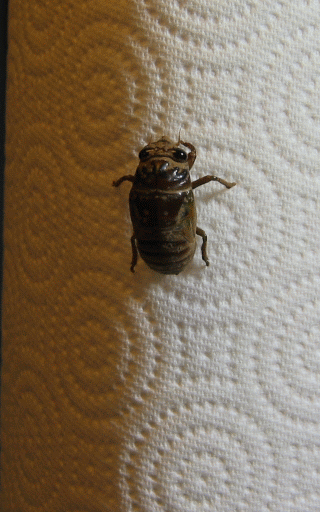Insects are a
highly successful and incredibly diverse group of organisms. Their success is due to a number of factors, one
of which is the exoskeleton. This
adaptation provides support, protection, and allows for the rapid and efficient
intake of oxygen.
Although the
exoskeleton provides several benefits, it also limits how large an insect can grow. The molting process leaves it vulnerable and
subject to bodily collapse until the new exoskeleton hardens.
 |
| Cicada Molting. Source: T. Nathan Mundhenk (Own work) GFDL (http://www.gnu.org/copyleft/fdl.html), via Wikimedia Commons |
As a result,
insects are relatively small in size, which has led to their success at
exploiting a great variety of ecological niches and resources.
But, insects
haven’t always been small.
Fossil
evidence from the Paleozoic Era shows that most insects were similar in size to
their modern counterparts. However, several
early groups were able to reach “gigantic” proportions.
Meganeuropsis permiana was the largest insect ever to have
lived. This early relative of modern
dragonflies and damselflies lived during from the late Carboniferous Period to
the Late Permian (320-247 MYA).
 |
| A life-size model of Meganeuropsis permiana at the Technische Universitaet Clausthal in Germany. Source: http://www.windsofkansas.com/meganeuropsiskraus.jpg |
Sometimes mistakenly called a “giant dragonfly”, the impressive predator was actually a “griffenfly”. Fossils
have shown the wingspan of M. permiana
could reach up to 28 inches (71 cm). In comparison, the largest extant damselfly is Megaloprepus
caerulatus 7.5 inches.
 |
| Source: Prehistoric Insects - ASU |
Fossils also show that several other invertebrate groups reached surprising
proportions, including early mayflies, myriapods, and scorpions.
There are a
number of proposed explanations as to why large insects were able to survive in
the distant past, as well as why they disappeared.
The atmosphere’s oxygen concentration was much
higher during the late Paleozoic and Early Mesozoic, which corresponds with the
existence of many giant insects.
It may
be that the hyperoxic conditions allowed an increase in size without a decrease
in respiration efficiency. The energetic
demands of flight of insects the size of Meganeuropsis
permiana would not have been possible without extra oxygen. Over time, oxygen levels declined, along with the prevalence of large insects.
There are
other explanations for the loss of the ancient giants. In 2012, researchers proposed that the evolution
of birds capable of agile flight corresponded with the timing of a decrease in
insect size, indicating the importance of competition and predation in species evolution and diversity (Clapham and Karr 2012).
 |
| Photo by Johnny Wee. Bird Ecology Study Group. www.besgroup.org |
Despite ongoing research and fossil discoveries, it's clear there are still many unanswered questions remaining about the evolution
and success of these ancient and fascinating organisms!
References:
Grimaldi,
D., & Engel, M. S. (2005). Evolution of the Insects. Cambridge University
Press.
Clapham, M.
E., & Karr, J. A. (2012). Environmental and biotic controls on the
evolutionary history of insect body size. Proceedings of the National Academy
of Sciences of the United States of America, 109(27), 10927–10930.
doi:10.1073/pnas.1204026109
Prehistoric Insects | ASU - Ask A Biologist: https://askabiologist.asu.edu/explore/big-big-bugs
Prehistoric Insects | ASU - Ask A Biologist: https://askabiologist.asu.edu/explore/big-big-bugs

No comments:
Post a Comment